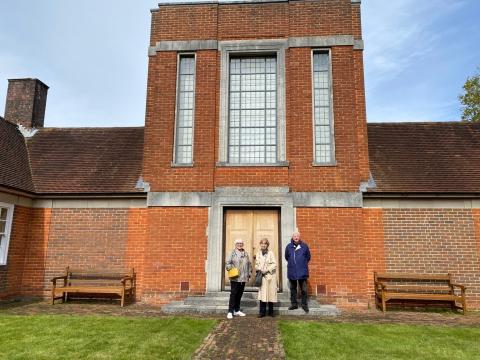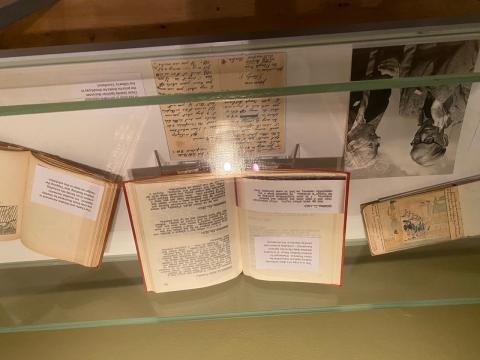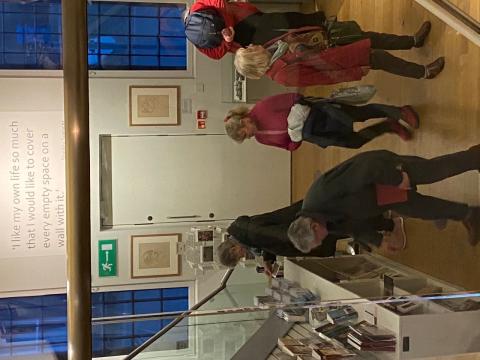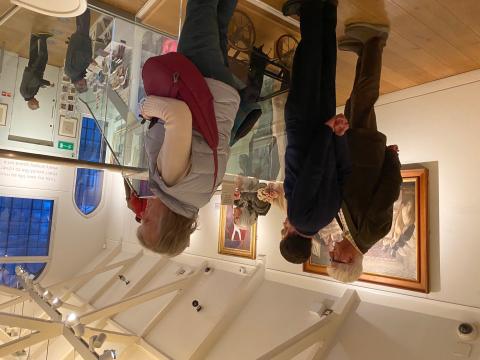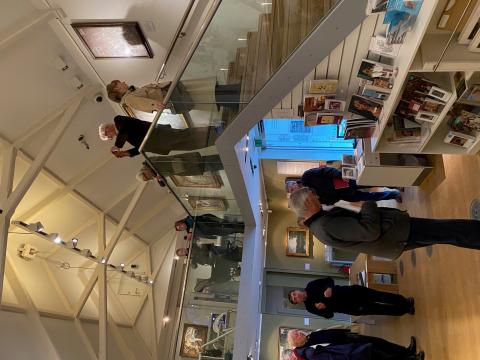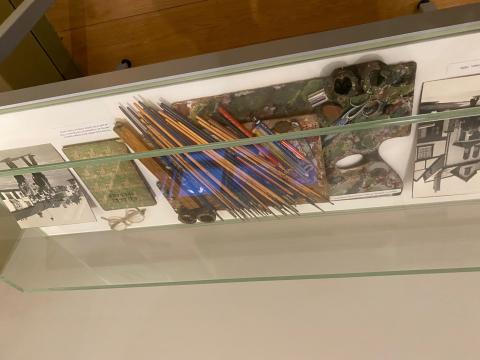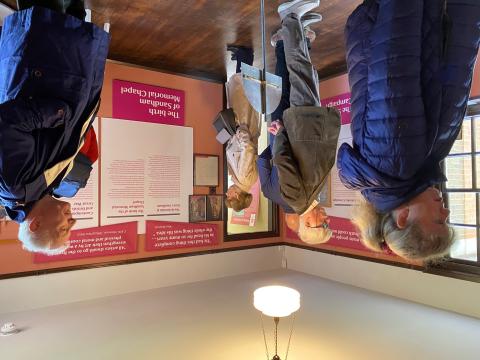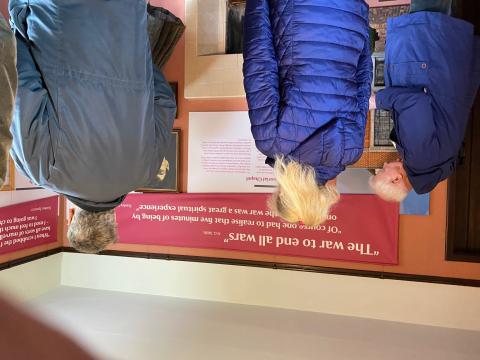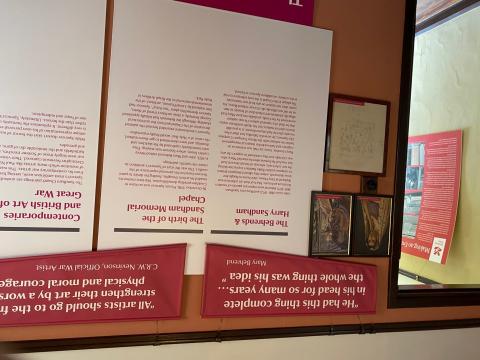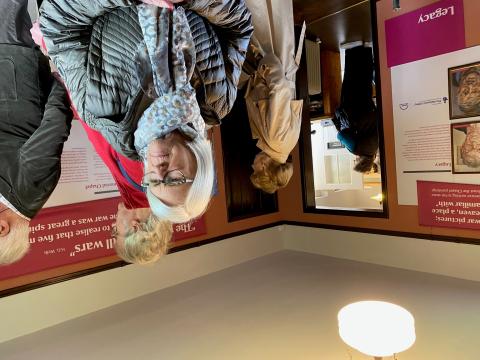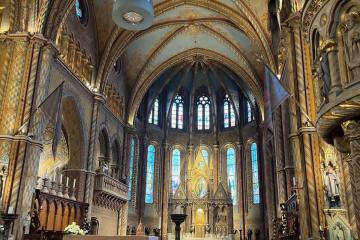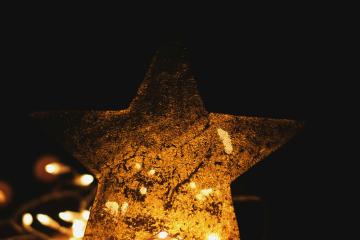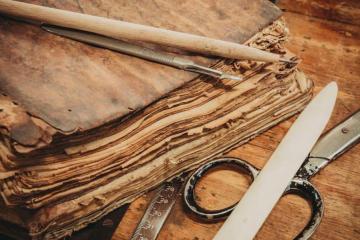More than twenty members of our Arts Society flew out in October 2025 for a short but fascinating trip discovering th
TAS Kington Langley Visit to Sandham Chapel and The Stanley Spencer Gallery, Cookham
TAS Kington Langley Visit to Sandham Chapel and The Stanley Spencer Gallery, Cookham
22 Apr 2024
‘The Holy Box’ ‘A Symphony in Rashers of Bacon’
Sandham Memorial Chapel (originally dedicated as the Oratory of all Souls)
We began our TASKL outing on a cold but sunny morning by viewing the background to a forgotten First World War front in Salonika and Stanley Spencer’s road to Macedonia. We then met Mark, our guide, who as an army chaplain was the ideal person to take us through the jewel-like box that is Sandham Chapel. The entire concept was Spencer’s and he was fortunate to acquire the backing of John Louis and Mary Behrend who were generous enough to support him in his overwhelming vision.
We began our visit through the museum where we found details of Spencer’s life as an hospital orderly and then as a medical orderly in Macedonia.
Inspired by Giotto’s Arena Chapel in Padua he wanted to ’build a church …and if I don’t do it on earth I will in heaven’. Spencer designed the chapel and then he designed the panels inside. He already was well known as an artist but this, probably his greatest work, came from his experiences as an orderly at the Beaufort War Hospital in Bristol and then from serving as a medical orderly in Macedonia. Not relishing his role at the bottom of the hierarchy he was given a copy of St. Augustine’s ‘Confessions’ and this taught Spencer to find God and solace in everyday tasks and routine. This philosophy – ‘being ever busy yet ever at rest’ seems to have informed his paintings in the chapel.
Spencer designed every aspect of the chapel but when it was dedicated neither he or the Behrends were there - he because the bishop didn’t like his resurrection painting and the family in support of Jean Louis’ Jewish faith.
After the initial and obligatory ‘WOW!’ as we entered the chapel we were able to see the paintings in detail. Oil paint on canvas specially measured for the individual panels and lit only by God’s Light has meant that the work is as rich as when they were painted back in the late 1920’s and early 30’s. We were not permitted to take photographs inside the Chapel so we suggest you pay it a visit.
‘The Resurrection of the Soldiers’ behind the alter dominates the whole chapel and all the other pieces are secondary and relate to it. This piece meant that Spencer worked in situ on a scaffold for a year and when he couldn’t think of a suitable background he looked out of the windows opposite and saw Watership Down - forever in the top left-hand section of the piece. Soldiers are emerging from their graves, greeting each other and then Christ is in the middle of the painting receiving the crosses from the soldiers.
We saw a series of arched paintings or predellas running around the lower part of the walls. – ‘Convoy Arriving with the Wounded’, and below ‘Scrubbing the Floor’. The next pair are ’Ablutions’ and ‘Sorting and Moving Kit Bags’. Mark reminded us that this is still the everyday life of soldiers, even today. Then we have ‘Kit Inspection’ and ‘Sorting the Laundry’. There is an enormous amount of detail in both these paintings and we have one of only two women depicted in the whole chapel. Finally, on the left-hand wall is ’Dug-Out (or Stand To)’ and underneath is ‘Filling Tea Urns’
Next on the right-hand side was ’Reveille’ and below it is ’Frostbite’ and for Spencer Reveille and Dug Out form a triptych with the Resurrection ‘a mixture of real and spiritual fact’. Following is ‘Filling Water Bottles’ and ‘Tea in the Hospital Ward’. We saw his compositions becoming more complicated. ‘Map-reading’ is the only painting to depict an officer and the horse stares out at us, unlike any other person in all of the paintings. ‘Bed -making’ shows the memory of making the beds probably from the hospital and includes paintings of people in Spencer’s life. The final two paintings show ’Firebelt’ as the soldiers create a fire break around their camp and below in ‘Washing Lockers’ we see Spencer’s fascination with the shape and colour of the baths. He wrote in 1929 ‘the baths were a deep sort of magenta and shiny and when you had a row of them end-view on, they looked marvellous’ He used to crawl in between them to seek solace and quiet. Above the predellas are two huge paintings the length of the walls. These are again canvass and had to be woven in Belgium as there were no looms large enough in England and Spencer wanted no seams.
The north wall – ‘Camp at Karasuli’ shows camp in the early morning - some men carrying stones, another stabbing loose newspaper with his bayonet while bacon rashers were being cooked on petrol stoves. Armies the world over at breakfast even today and finally on the south wall- ‘Riverbed at Todorovo’ Again we see everyday life in the army as it moves between fronts – playing games, creating patterns out of stones.
Nowhere do we see death, munitions, arms, mutilation but the comradeship between the men, their animals, the tasks to be carried out. The paintings represent the mundane as it was infused with a spirituality and this allowed him to survive life on the front. Even though no one smiles in the paintings or looks at the viewer Spencer was insistent that it was a ‘happy place’
The whole work is unique in English art with its connections between artist, patrons and the sheer majesty of the whole concept.
After a very convivial lunch in the pub across the road we then travelled to the Stanley Spencer Gallery in Cookham. This is the chapel in which Spencer and his family worshiped when he was growing up in the village. Currently there was an exhibition of some of Gilbert Spencer’s work. He painted landscapes usually including farm horses and yards. We had a guided tour of the gallery and gained a good insight into Spencer’s early life and then his rather unconventional marriages to Hilda and Patricia. We heard of the effect the two women had on his work, his life and the bizarre love triangle between them.
He loved Cookham and in his imagination it became a ’village in heaven’ and the focus for his fervent religious and spiritual values. His vision was rare in English art and we were able to experience some of his ideas and beliefs as we listened to our guides and explored the work and imagined angels walking around us in Cookham. An excellent day out
Much of his work is held between the Stanley Spencer Gallery and the Tate has the largest collection of his work in the world.
About the Author
Heather Leach Chair TASKL
- sandam
- spencer
- cookham
Article Tags
JOIN OUR MAILING LIST
Become an instant expert!
Find out more about the arts by becoming a Supporter of The Arts Society.
For just £20 a year you will receive invitations to exclusive member events and courses, special offers and concessions, our regular newsletter and our beautiful arts magazine, full of news, views, events and artist profiles.
FIND YOUR NEAREST SOCIETY
MORE FEATURES
Year in Review: A Remarkable Year for The Arts Society Mallorca
Our Heritage Volunteers are working as part of a team working on the rewarding book restoration proj


